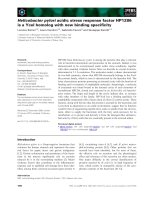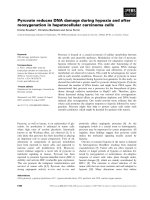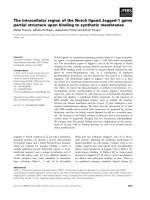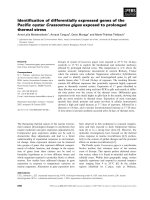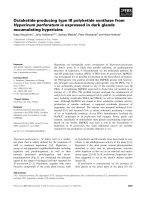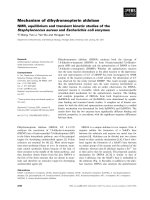báo cáo khoa học:" Pain management procedures used by dental and maxillofacial surgeons: an investigation with special regard to odontalgia" pdf
Bạn đang xem bản rút gọn của tài liệu. Xem và tải ngay bản đầy đủ của tài liệu tại đây (233.26 KB, 5 trang )
BioMed Central
Page 1 of 5
(page number not for citation purposes)
Head & Face Medicine
Open Access
Research
Pain management procedures used by dental and maxillofacial
surgeons: an investigation with special regard to odontalgia
Stefan Wirz*
†
, Hans Christian Wartenberg
†
and Joachim Nadstawek
†
Address: Outpatients Pain Clinic – Department of Anaesthesiology and Intensive Care Medicine, University of Bonn, Sigmund-Freud-Str. 25, D-
53105 Bonn, Germany
Email: Stefan Wirz* - ; Hans Christian Wartenberg - ; Joachim Nadstawek -
bonn.de
* Corresponding author †Equal contributors
Abstract
Background: Little is known about the procedures used by German dental and maxillofacial
surgeons treating patients suffering from chronic orofacial pain (COP). This study aimed to evaluate
the ambulatory management of COP.
Methods: Using a standardized questionnaire we collected data of dental and maxillofacial
surgeons treating patients with COP. Therapists described variables as patients' demographics,
chronic pain disorders and their aetiologies, own diagnostic and treatment principles during a
period of 3 months.
Results: Although only 13.5% of the 520 addressed therapists returned completely evaluable
questionnaires, 985 patients with COP could be identified. An orofacial pain syndrome named
atypical odontalgia (17.0 %) was frequent. Although those patients revealed signs of chronification,
pain therapists were rarely involved (12.5%). For assessing pain the use of Analogue Scales (7%) or
interventional diagnostics (4.6%) was uncommon. Despite the fact that surgical procedures are
cofactors of COP therapists preferred further surgery (41.9%) and neglected the prescription of
analgesics (15.7%). However, most therapists self-evaluated the efficacy of their pain management
as good (69.7 %).
Conclusion: Often ambulatory dental and maxillofacial surgeons do not follow guidelines for COP
management despite a high prevalence of severe orofacial pain syndromes.
Background
Many heterogeneous diseases lead to orofacial pain syn-
dromes. Descriptions such as jaw (temporomandibular)
joint pain, facial pain, and dental pain characterise these
syndromes with regional anatomic descriptions. The
International Headache Society [1-3] distinguishes orofa-
cial pain syndromes from other painful conditions.
A perseverance of pain longer than 6 months and emerg-
ing signs of chronification, as a strong association with
psychosocial problems, frequent changes of therapists,
localisation of pain in other parts of the body, defines
chronic orofacial pain [4-7]. Chronic orofacial pain very
often has an economic impact on health care systems [8].
The female gender is affected, mostly. References show
that prevalences of orofacial pain syndromes vary from a
Published: 22 December 2005
Head & Face Medicine 2005, 1:14 doi:10.1186/1746-160X-1-14
Received: 22 September 2005
Accepted: 22 December 2005
This article is available from: />© 2005 Wirz et al; licensee BioMed Central Ltd.
This is an Open Access article distributed under the terms of the Creative Commons Attribution License ( />),
which permits unrestricted use, distribution, and reproduction in any medium, provided the original work is properly cited.
Head & Face Medicine 2005, 1:14 />Page 2 of 5
(page number not for citation purposes)
6 month period prevalence of 12 to 22% to a 12 month
prevalence of 20% [9-15].
The management of orofacial pain remains difficult.
Often therapists cause a vicious circle by applying inade-
quate invasive treatment principles resulting in persistent
pain conditions which then, for their part, force therapists
to carry out further invasive procedures [8,16].
Only few investigations are publicized on the manage-
ment of patients with orofacial pain treated by general
physicians, pain therapists dental, or maxillofacial sur-
geons. A detailed assessment of pain therapy methods was
not the objective of these studies [4,5,12,17]. Patients suf-
fering from chronic orofacial pain are frequent in the Out-
patients Pain Clinic of the University of Bonn, Germany.
Previously, many of them had visited dental and maxillo-
facial surgeons. Contradictory, we knew only little about
the diagnostic and therapeutic principles of these col-
leagues.
Therefore, this investigation aims to evaluate the ambula-
tory management of chronic orofacial pain syndromes by
dental and maxillofacial surgeons within a defined Ger-
man regional area, adjacent to our clinic. By assessing var-
ious diagnostic and therapeutic procedures we intended
an evaluation of the realisation of the principles 'interdis-
ciplinarity' and 'multimodality'. Furthermore, this investiga-
tion should describe demographic patterns of patients
suffering from chronic orofacial pain syndromes.
Methods
This investigation was designed as a descriptive, observa-
tional and cross-sectional case study.
In the 3rd quarter of the year 2001, the investigators sent
questionnaires to all 508 dental surgeons and all 12 max-
illofacial surgeons working in ambulatory capacities in a
German county in the Rhine area containing 882,000 res-
idents, called Rhein-Sieg-Kreis and Bundesstadt Bonn.
Questions referred to the number of patients suffering
from orofacial pain during the 2nd quarter of the year
2001, their gender, age (expressed in decades), general
medical characteristics, the classification of headaches
and orofacial pain according the International Headache
Society (IHS), and the aetiologies of pain. For the assess-
ment of diagnoses, etiological factors, and the durations
of pain we used standardised forms based on the IHS and
the International Classification of Diseases, Version 10
(ICD-10).
Further points were the course of diagnostic procedures,
including specialised diagnostic procedures, as radiologi-
cal, neurophysiological, – especially electromyography -,
and interventional procedures, as diagnostic blocks, or
local anaesthesia. The investigators asked explicitly
whether therapists knew or used visual analogue or
numerical rating scales for assessing pain.
Other questions involved the use and prescription of anal-
gesics – such as nsaids, opioids, anticonvulsants, antide-
pressants, and muscle relaxants – and surgical procedures,
such as tooth extractions, or interventional procedures,
such as local anaesthesia or sympathetic blocks. All thera-
pists were given the opportunity to rate the efficacy of
their management of orofacial pain syndromes in a three
step scale ('poor', 'indifferent', 'good').
For the evaluation of the principle 'interdisciplinarity', all
disciplines of therapists, including all medical and non-
medical therapists, involved in the treatment of the
patients experiencing orofacial pain were recorded.
Data were analysed descriptively by means of absolute
numbers and percentages. Based on the total number of
patients with chronic orofacial pain a three month preva-
lence was calculated for this sample.
Results
Seventy-two of the 520 surveyed ambulatories returned
completely evaluable questionnaires (13.5%). They
reported 985 patients with orofacial pain being treated in
the quarter in question. The calculated 3 month preva-
lence of orofacial pain based on 882,000 residents in the
investigated county was 0.1%.
66.8% of patients with orofacial pain were female. Table
1 describes the distribution of the age decades of the sam-
ple. We found 81.1% of patients with an age between 20
to 60 years (mean age 31.9, minimum 7, maximum 88
years). No data on age was documented for 35 patients.
Patient diagnoses are listed in Table 2. Temporomandibu-
lar disorders (TMD), orofacial pain associated with head-
ache syndromes and atypical odontalgia were very
frequent.
Etiological factors of orofacial pain could be revealed in
only 546 cases (55.4%). Detailed information is given in
Table 3.
392 patients (39.8%) demonstrated co-morbidity. This
involved orthopaedic (130 patients/33.2%), internal
(127 patients/32.4%), psychosomatic (89 patients/
22.7%), neurological (11 patients/2.8%), and psychiatric
(14 patients/3.6%) causes.
Individual durations of orofacial pain were documented
in 681 patients (69.1%). Pain persevered longer than 6
Head & Face Medicine 2005, 1:14 />Page 3 of 5
(page number not for citation purposes)
months in 61.1%, longer than 3 years in 21.3%, and
longer than 5 years in 5.3%.
In most cases, diagnostics were carried out in the form of
patient history and a general examination. Only 17.0% of
the therapists knew of numerical rating or visual analogue
scales as methods for assessing pain intensity. Only 7%
used this device regularly. Specialised procedures, e.g.
diagnostic local diagnostic blocks (4.7%), or neurophysi-
ological procedures (5.7%), were rarely applied. How-
ever, radiological diagnostics were more frequent
(52.4%).
Nevertheless, in 28.7% of patients the delay of diagnostic
procedures lasted longer than one year. The diagnostics of
three patients had not been completed over 15 years.
Table 4 gives more details.
538 patients (54.6%) taking part in the survey had
changed therapists before attending the ambulatory.
60.6% of these had changed their therapist more than
three times.
Table 5 describes the enrolment of other disciplines in
pain therapy. Further therapists were involved in diagnos-
tics and therapy 761 times. Most frequently maxillofacial
surgeons and pain therapists were involved, but the
number of non-medical therapists exceeded the number
of pain therapists. These consisted of physiotherapists and
non-medical practitioners, a profession with permission
to treat patients which exists in Germany only. Non-med-
ical practitioners regularly use alternative medicine, such
as traditional Chinese or Ayurvedic medicine, or homeop-
athy.
Although 985 patients suffered from chronic orofacial
pain, only 635 received a documented treatment, as can
be seen in Table 6. The use of further surgical procedures,
e.g. tooth extraction, treatment of dental roots, was more
frequent than the use of physiotherapy, analgesics or the
treatment of a malocclusion. Eighty patients (8.1%)
received nsaids, 9 (0.9%) opioids, 6 (0.7%) muscle relax-
ants and 4 (0.4%) anticonvulsants. The use of local anaes-
thesia was documented in 16 patients. Further
interventional procedures, such as sympathetic blocks,
were not used at all.
Responding colleagues self-evaluated the therapeutic effi-
cacy of their methods applied in 885 cases (89.8%). In
their perception, pain conditions of most patients
improved. Pain rarely worsened, while no change was
observed in nearly one-in-five patients, as listed in Table
7.
Discussion
The use of a questionnaire is an established method for
assessing the management of pain syndromes in patients,
but the quota of respondents taking such an approach typ-
ically is small [5,6,12,17], as demonstrated in our investi-
gation. Possibly, our questionnaire particularly induced
responses from therapists with a very difficult clientele.
However, with nearly 1,000 patients currently being
treated in 72 ambulatory dental and maxillofacial surger-
ies experiencing orofacial pain syndromes, the number
was unexpectedly high compared to other studies [12].
On the other hand, the prevalence of orofacial pain
extrapolated to all residents in the area of investigation
was rather small, compared to other surveys which
directly assess the population [4,9,12,13,15,18,19]. Con-
tradictory to other references [11] and the general demo-
graphic data of this region, this investigation yielded a low
rate of elderly people suffering from chronic orofacial
pain, especially patients older than 60 years of age. How-
ever, the higher prevalence of orofacial pain in females, as
described by other authors, was documented again [9,10].
We could not define etiological factors in nearly 50 % of
patients with chronic orofacial pain. Surgical procedures,
– especially if explorative and not correctly indicated -,
revealed their harmful impact on chronification of pain.
The frequency of TMD diagnosis corresponded to other
investigations, but the number of patients with the diag-
nosis atypical odontalgia including phantom tooth pain was
unexpectedly high [14,15,18-22]. Deficits in knowledge
of that pain condition, or effect of a selection (as men-
tioned above), might explain this. Some authors [8,14,21]
could not identify atypical odontalgias because of meth-
odological reasons, or just described it as dental pain,
demonstrating an elevated prevalence [9,11]. Possibly,
the epidemiological impact of atypical odontalgia is
underestimated.
Atypical odontalgia is a severe and chronic pain disorder
characterised by persistent pain with apparent clinical
normal teeth. Clinical and radiographic examination does
not reveal any pathologic findings. Neuropathic signs as
allodynia and hyperalgesia are common and suggest a
neuropathic origin of this pain. Heat, cold, pressure do
not necessarily modulate pain. Local anaesthetics often
have no impact. There is an elevated risk of chronification,
as therapists often attempt vain interventional or surgical
procedures [23-25].
Atypical odontalgia can be associated with atypical facial
pain. Some authors consider atypical odontalgia to be a
subgroup of atypical facial pain [20]. On the other hand,
phantom tooth pain can be regarded as a special form of
Head & Face Medicine 2005, 1:14 />Page 4 of 5
(page number not for citation purposes)
atypical odontalgia [26], a condition which occurred very
often in this survey [27-29]. Furthermore, this investiga-
tion underlines the close relationship between both pain
disorders.
The high number of patients involved in the working
process underlines the possible socio-economic impact of
orofacial pain. Unfortunately, socio-economic parameters
(or at least of their being 'off work' due to orofacial pain)
could not be documented. Nevertheless, patients with
chronic orofacial pain revealed signs of chronification or
an association with psychosomatic complaints. Other
authors [15,18,28,29] also reported this association with
headache syndromes.
This investigation showed that ambulatory therapists
rarely followed the guidelines for the management of oro-
facial pain published by the American Academy of Orofa-
cial Pain (AAOP) [30] and the German chapter of the
International Association for the Study of Pain (Deutsche
Gesellschaft zum Studium des Schmerzes – DGSS) [31].
Therapist skipped important and easily applicable devices
as analogue scales for the assessment of pain intensity or
diagnostic local anaesthesia. Despite a high co-morbidity
with psychosomatic disorders, psychological or psychiat-
ric diagnostics were omitted, causing further delays of the
exact diagnostic process [7,17,23].
According to other references this investigation demon-
strated another central neglect: the exclusion of an analge-
sic mediation in favour of surgery is an important
etiological factor of the chronification of pain [31].
Although therapists have recognized its significance they
to not perform the multimodal approach comprising dif-
ferent elaborated therapeutic strategies [6-8,16,17,21,23].
Treatment seldom comprises multidisciplinary aspects
[17]: only few dentists and maxillofacial surgeons con-
sulted colleagues from other disciplines, as pain thera-
pists, neurologists, or psychiatrists.
Contradictory, dental and maxillofacial surgeons high-
rated the efficacy of their procedures. The high number of
'successful' treatments contrasts with other references [5-
7,23]. Possibly, causes are perceptive, communicative def-
icits, or administrative limitations of therapists treating
severe and chronic orofacial pain syndromes.
Conclusion
In the current management of patients suffering from oro-
facial pain syndromes ambulatory dental and maxillofa-
cial surgeons ignore the principles of a multimodal and
interdisciplinary pain therapy, despite their publication in
various guidelines. A standardised concept of surgical,
interventional and analgesic procedures has not been
implemented so far. Therapists apply surgical procedures
as tooth extractions or other surgical techniques rather
than analgesics, minimal-invasive pain therapy, physio-
therapy or other conservative procedures, although severe
pain syndromes, such as atypical odontalgias, seem to be
frequent in the sample population. Further prospective
investigations and educational and communicative efforts
should contribute to improving this situation.
Competing interests
The author(s) declare that they have no competing inter-
ests.
Authors' contributions
All authors were equally involved in the study design, data
extraction, data analysis, and preparation of the manu-
script.
Acknowledgements
The investigators thank all colleagues who answered the questionnaires and
provided information. Investigation on that field is impossible without such
support. Furthermore the investigators thank Thomas Korthaus for helping
us in organizing the study and data collection.
References
1. Okeson JP: Orofacial Pain. Guidelines for Assessment, Diagnosis, and Man-
agement. The American Academy of Orofacial Pain Quintessence Publish-
ing Co, Inc, Chicago, Berlin, London; 1996.
2. Olesen J: Classification and diagnostic criteria for headache
disorders, cranial neuralgias and facial pain. Cephalalgia 1988,
8(Suppl 7):1-96.
3. Blank LW: Clinical guidelines for managing mandibular dys-
function. Gen Dent 1998, 46:592-597.
4. Chrubasik S, Junck H, Zappe HA, Stutzke O: A survey on pain
complaints and health care utilization in a German popula-
tion sample. Eur J Anesthesiol 1998, 15:397-408.
5. Dahlstrom L, Lindvall AM, Milthon R, Widmark G: Management of
chronic orofacial pain: attitudes among patients and dentists
in a Swedish county. Acta Odontol Scand 1997, 55:181-185.
6. Lebovits AH, Florence I, Bathina R, Hunko V, Fox MT, Bramble CY:
Pain knowledge and attitudes of healthcare providers: prac-
tice characteristic differences. Clin J Pain 1997, 13:237-243.
7. Murray H, Locker D, Mock D, Tenenbaum H: Patient satisfaction
with a consultation at a cranio-facial pain unit. Community Dent
Health 1997, 14:69-73.
8. Turp JC, Kowalski CJ, Stohler CS: Treatment-seeking patterns of
facial pain patients: Many possibilities, limited satisfaction. J
Orofac Pain 1998, 12:61-66.
9. Lipton JA, Ship JA, Larach-Robinson D: Estimated prevalence and
distribution of reported orofacial pain in the United States.
J Am Dent Assoc 1993, 124:115-121.
10. Riley JL, Gregg HG: Orofacial pain symptoms: an interaction
between age and sex. Pain 2001, 90:245-256.
11. Riley JL, Gregg HG, Heft MW: Orofacial pain symptom preva-
lence: selective sex differences in the elderly? Pain 1998,
76:97-104.
12. Sindet-Pedersen S, Petersen JK, Gotzsche PC: Incidence of pain
conditions in dental practice in a Danish county. Community
Dent Oral Epidemiol 1985, 13:244-246.
13. Kohlmann T: Epidemiology of orofacial pain. Schmerz 2002,
16:339-345.
14. Vickers ER, Cousins MJ, Woodhouse A: Pain description and
severity of chronic orofacial pain conditions. Aust Dent J 1998,
43:403-409.
15. Von Korff M, Dworkin SF, LeResche L, Kruger A: An epidemiologic
comparison of pain complaints. Pain 1988, 32:173-183.
16. Milam SB: Failed implants and multiple operations. Oral Surg
Oral Med Oral Pathol Oral Radiol Endod 1997, 83:156-162.
Publish with Bio Med Central and every
scientist can read your work free of charge
"BioMed Central will be the most significant development for
disseminating the results of biomedical research in our lifetime."
Sir Paul Nurse, Cancer Research UK
Your research papers will be:
available free of charge to the entire biomedical community
peer reviewed and published immediately upon acceptance
cited in PubMed and archived on PubMed Central
yours — you keep the copyright
Submit your manuscript here:
/>BioMedcentral
Head & Face Medicine 2005, 1:14 />Page 5 of 5
(page number not for citation purposes)
17. Lang E, Eisele R, Bickel A, Winter E, Schlabeck , Kastener S, Sittl R,
Liebig K, Martus B, Neundoerfer E: Structure quality in outpa-
tient care of chronic pain patients. Schmerz 1999, 13:102-112.
18. Kohlmann T: Pain complaints among inhabitants of Luebeck:
results of a population-based epidemiologic study. Schmerz
1999, 5:208-213.
19. Schuhmacher J, Brähler E: The prevalence of pain in the German
population: Results of population-based studies with the
Giessen Subjective Complaints List (Giessener Beschwerde-
bogen). Schmerz 1999, 6:375-84.
20. Vickers ER, Cousins MJ: Neuropathic orofacial pain part 1 –
prevalence and pathophysiology. Aust Endod J 2000, 26:19-26.
21. Marbach JJ, Hulbrock J, Hohn C, Segal AG: Incidence of phantom
tooth pain: an atypical facial neuralgia. Oral Surg Oral Med Oral
Pathol 1982, 53:190-193.
22. Campbell RL, Parks KW, Dodds RN: Chronic facial pain associ-
ated with endodontic therapy. Oral Surg Oral Med Oral Pathol
1990, 69:287-290.
23. Turp JC: Atypical odontalgia – a little known phantom pain.
Schmerz 2001, 15:59-64.
24. Woda A, Pionchon P: A unified concept of idiopathic orofacial
pain: clinical features. J Orofac Pain 1999, 13:172-184.
25. Woda A, Pionchon P: A unified concept of idiopathic orofacial
pain: pathophysiologic features. J Orofac Pain 2000, 14:196-212.
26. Woda A, Pionchon P: Orofacial idiopathic pain: clinical signs,
causes and mechanisms. Rev Neurol 2001, 157:265-83.
27. Pertes RA, Bailey DR, Milone AS: Atypical odontalgia – a nonden-
tal toothache. J N J Dent Assoc 1995, 66:29-31.
28. Nicolodi M, Sicuteri F: Phantom tooth diagnosis and an anam-
nestic focus on headache. N Y State Dent J 1993, 59:35-37.
29. Graff-Radford SB, Solberg WK: Atypical odontalgia. J Cranioman-
dib Disord 1992, 6:260-265.
30. Merksey H, Bogduk N: Classification of Chronic Pain 2nd edition. IASP
Press, Seattle; 1994.
31. Turp JC, John M, Nilges P, Jurgens J: Recommendations for the
standardized evaluation and classification of patients with
painful temporomandibular disorders. Schmerz 2001,
4:416-428.

